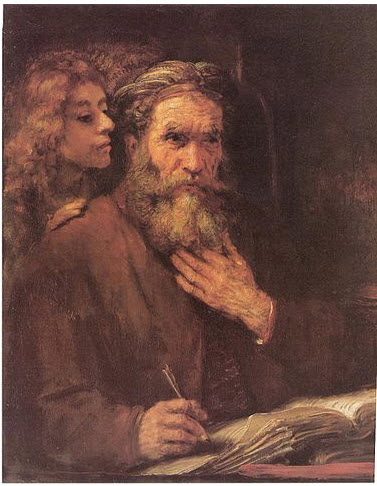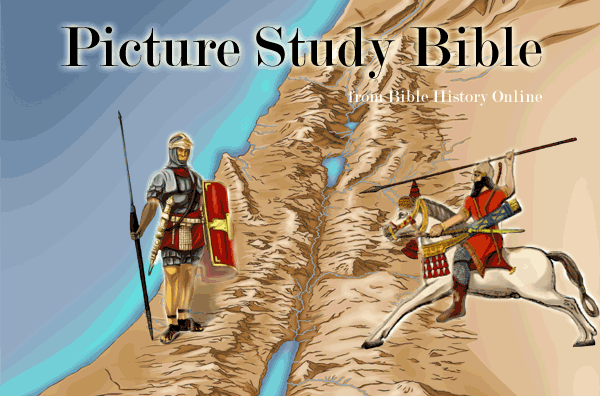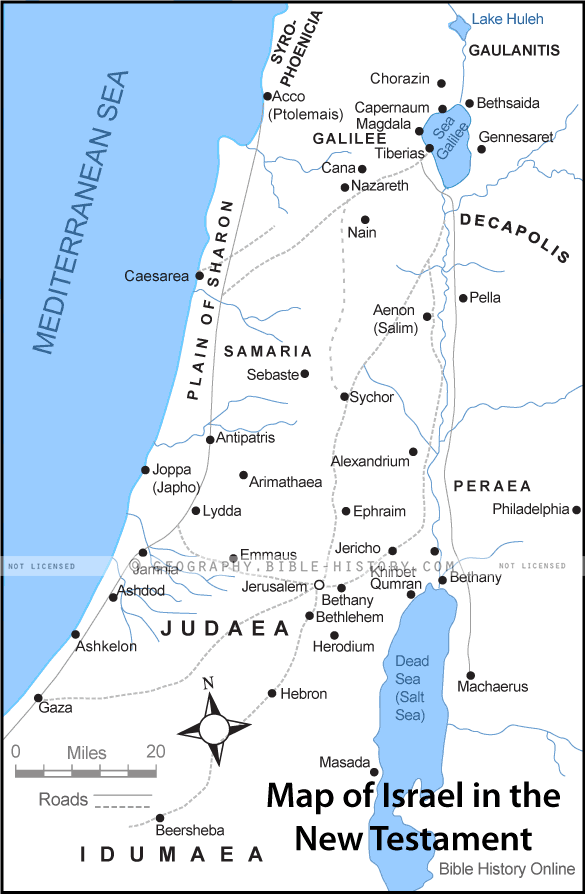Matthew 27:51 And, behold, the veil of the temple was rent in twain from the top to the bottom; and the earth did quake, and the rocks rent; - Free Bible Online
Matthew 27:51 And behold, the veil of the temple was torn in two from top to bottom, and the earth shook; and the rocks were split,
Mt 27:51-66. SIGNS AND CIRCUMSTANCES FOLLOWING THE DEATH OF THE LORD JESUS--HE IS TAKEN DOWN FROM THE CROSS, AND BURIED--THE SEPULCHRE IS GUARDED. ( = Mr 15:38-47; Lu 23:47-56; Joh 19:31-42).
The Veil Rent (Mt 27:51).
51. And, behold, the veil of the temple was rent in twain from the top to the bottom--This was the thick and gorgeously wrought veil which was hung between the "holy place" and the "holiest of all," shutting out all access to the presence of God as manifested "from above the mercy seat and from between the cherubim"--"the Holy Ghost this signifying, that the way into the holiest of all was not yet made manifest" (Heb 9:8). Into this holiest of all none might enter, not even the high priest, save once a year, on the great day of atonement, and then only with the blood of atonement in his hands, which he sprinkled "upon and before the mercy seat seven times" (Le 16:14) --to signify that access for sinners to a holy God is only through atoning blood. But as they had only the blood of bulls and of goats, which could not take away sins (Heb 10:4), during all the long ages that preceded the death of Christ the thick veil remained; the blood of bulls and of goats continued to be shed and sprinkled; and once a year access to God through an atoning sacrifice was vouchsafed--in a picture, or rather, was dramatically represented, in those symbolical actions--nothing more. But now, the one atoning Sacrifice being provided in the precious blood of Christ, access to this holy God could no longer be denied; and so the moment the Victim expired on the altar, that thick veil which for so many ages had been the dread symbol of separation between God and guilty men was, without a hand touching it, mysteriously "rent in twain from top to bottom"--"the Holy Ghost this signifying, that the way into the holiest of all was NOW made manifest!" How emphatic the statement, from top to bottom; as if to say, Come boldly now to the Throne of Grace; the veil is clean gone; the mercy seat stands open to the gaze of sinners, and the way to it is sprinkled with the blood of Him--"who through the eternal Spirit hath offered Himself without spot to God!" Before, it was death to go in, now it is death to stay out. See more on this glorious subject on Heb 10. 19-22.
An Earthquake--The Rocks Rent--The Graves Opened, that the Saints Which Slept in Them Might Come Forth after Their Lord's Resurrection (Mt 27:51-53).
51. and the earth did quake--From what follows it would seem that
this earthquake was local, having for its object the rending of the
rocks and the opening of the graves.
and the rocks rent--"were rent"--the physical creation thus sublimely
proclaiming, at the bidding of its Maker, the concussion which at
that moment was taking place in the moral world at the most critical
moment of its history. Extraordinary rents and fissures have been
observed in the rocks near this spot.
JFB.
Questions Related to this Verse
Where in Scripture does it mention earthquakes at the crucifixion of Jesus?Where in Scripture does it say that Jesus was crucified just outside Jerusalem?
Where in Scripture does it mention The veil of the temple was torn in half at the time of the crucifixion?
Where in Scripture does it mention The veil of the Temple was torn from the top to the bottom at the time of the crucifixion of Jesus?
Where in Scripture does it mention Jesus being crucified just outside Jerusalem?
Select a Chapter
-
Matthew 1 |
Matthew 2 |
Matthew 3 |
Matthew 4 |
Matthew 5 |
Matthew 6 |
Matthew 7 |
Matthew 8 |
Matthew 9 |
Matthew 10 |
Matthew 11 |
Matthew 12 |
Matthew 13 |
Matthew 14 |
Matthew 15 |
Matthew 16 |
Matthew 17 |
Matthew 18 |
Matthew 19 |
Matthew 20 |
Matthew 21 |
Matthew 22 |
Matthew 23 |
Matthew 24 |
Matthew 25 |
Matthew 26 |
Matthew 27 |
Matthew 28 |
Select a Book of the Bible
-
Genesis |
Exodus |
Leviticus |
Numbers |
Deuteronomy |
Joshua |
Judges |
Ruth |
1 Samuel |
2 Samuel |
1 Kings |
2 Kings |
1 Chronicles |
2 Chronicles |
Ezra |
Nehemiah |
Esther |
Job |
Psalms |
Proverbs |
Ecclesiastes |
Song of Solomon |
Isaiah |
Jeremiah |
Lamentations |
Ezekiel |
Daniel |
Hosea |
Joel |
Amos |
Obadiah |
Jonah |
Micah |
Nahum |
Habakkuk |
Zephaniah |
Haggai |
Zechariah |
Malachi |
Matthew |
Mark |
Luke |
John |
Acts |
Romans |
1 Corinthians |
2 Corinthians |
Galatians |
Ephesians |
Philippians |
Colossians |
1 Thessalonians |
2 Thessalonians |
1 Timothy |
2 Timothy |
Titus |
Philemon |
Hebrews |
James |
1 Peter |
2 Peter |
1 John |
2 John |
3 John |
Jude |
Revelation |
The Book of Matthew
Matthew 2:2 - Where is he that is born King of the Jews? for we have seen his star in the east, and are come to worship him.
Matthew 18:3 - And Jesus said, Verily I say unto you, Except ye be converted, and become as little children, ye shall not enter into the kingdom of heaven.
Matthew in The New Testament - A Brief Overview

Painting of St. Matthew with Angel by Rembrandt
The Word Gospel. The first book of the English Bible that most of us read from is the Gospel of Matthew. Matthew is the first of the four gospel writings, yet there is only one gospel about Jesus Christ and there are four different writers: Matthew, Mark, Luke, and John. The word "Gospel" means "good news", and the good news is about Jesus Christ dying on the cross and then 3 days later conquering death and rising from the dead, offering salvation to all mankind, this is the Gospel.
Summary of the Book of Matthew
Brief Summary. Jesus of Nazareth is indeed the long awaited Messiah King of he Jews as foretold by the ancient Jewish prophets. He came to reveal how to enter the "Kingdom of Heaven."
Purpose. It is very obvious that the Gospel of Matthew was written for the purpose of revealing that the man Jesus of Nazareth was actually the King of the Jews, the long awaited Messiah, the sovereign Lord Jehovah who came from heaven to this world revealing to mankind the "kingdom of heaven". The King of the Jews, the Messiah Jesus fulfilled every prophecy that was spoken about Him in the ancient Jewish Scriptures, in the Old Testament. The prophecies that spoke of the "Kingdom" that the Messiah would bring would be a spiritual Kingdom that would never be destroyed.
Audience. When reading the book of Matthew it becomes clear that the writer was speaking to a Jewish audience. One of the obvious reasons is that the "Kingdom of Heaven" is mentioned over 30 times and never the Kingdom of God. This is because the Jews do not speak the name of God and this could be the very reason that Matthew used this phrase. There are many times while reading the book that an event happens and a prophecy is cited. The event is mentioned as the direct fulfillment of a promise made to the Jews by one of their Jewish prophets, and the fulfillment of the prophecy was happening before their very eyes. It is clear that the audience of people are the Jews, they were awaiting their King, and Matthew records that the King had come and they rejected their King.
Authorship. Early Christian writings and traditions have attributed the authorship of the Gospel of Matthew to the apostle Matthew. Many scholars question whether or not Matthew was the true author of the first Gospel, but there is no way at this current time to be absolutely positive based on historical evidence. Most agree that Matthew was the author. The Bible reveals that Matthew, or Levi, as he was sometimes called, collected taxes for the Romans. One day Jesus passed by and called Matthew to come and follow him, and Matthew did so. The Bible also records that Matthew held a banquet at his house with several of his tax collector friends and Jesus being invited to the banquet was the guest of honor (Mark 2:14-15). The Bible also provides a list of the 12 apostles and Matthew was named among them.
Date. There is no way to determine with absolute certainty the date that the book of Matthew was written. Most scholars agree that the book of Matthew was written before the destruction of Jerusalem in 70 A.D., this is because Jesus spoke of many events as though they had not happened yet. A large number of scholars do not believe in the miracle of prophecy and therefore insist that the Gospel of Matthew was written after the fall of Jerusalem because of the accuracy of the predicted events.
Language. There are many references among the books in the history of the early church that state that the Gospel of Matthew was originally written by Matthew in the biblical Hebrew language, and he was writing to an audience of Jews throughout the world who had become followers of Jesus. Unfortunately there is no evidence whatsoever of a Hebrew or Aramaic manuscript, so many scholars have agreed that the Gospel of Matthew is not actually a translation from Hebrew into Greek, but was actually written in Greek. The whole subject of the Gospel of Matthew being written in Hebrew must remain speculation rather than fact.
Outline of the Book of Matthew
The King Comes and His Kingdom is Rejected -
Matthew 1-12
The Rejection of the King's Teaching and Ministry -
Matthew 13-25
The King's Trial and Crucifixion - Matthew 26-27
The King's Victory and Resurrection - Matthew 28
The King's Commissioning of His Apostles -
Matthew 28
Matthew - Interesting Notes
![]() Matthew mentions four women in his genealogy which is not
typical for Jewish genealogical records: Tamar, Rahab,
Ruth, Bathsheeba who were all associated with some sort of
immorality. Tamar (incest), Rahab (harlotry), Ruth (a descendant
of Moab who committed incest) and Bathsheba (adultery). Christ's
greatness was in Himself not his genealogy.
Matthew mentions four women in his genealogy which is not
typical for Jewish genealogical records: Tamar, Rahab,
Ruth, Bathsheeba who were all associated with some sort of
immorality. Tamar (incest), Rahab (harlotry), Ruth (a descendant
of Moab who committed incest) and Bathsheba (adultery). Christ's
greatness was in Himself not his genealogy.
![]() There are many intimations for the word "King" in Matthew if one takes
the time to look. For example in chapter one there is a royal genealogy
mentioning king David at the start. Chapter two reveals the kingly gifts
of the Magi. Chapter three calls John the Baptist a "herald" which is a
cultural term that represents a herald for a king. Etc.
There are many intimations for the word "King" in Matthew if one takes
the time to look. For example in chapter one there is a royal genealogy
mentioning king David at the start. Chapter two reveals the kingly gifts
of the Magi. Chapter three calls John the Baptist a "herald" which is a
cultural term that represents a herald for a king. Etc.
![]() There are similarities with the number four. The four colors in the veil
of the Temple were purple, scarlet, white, and blue. The four faces of
the cherubim are the lion, ox, man, eagle. The four Gospel accounts are
Matthew, Mark, Luke, John.
There are similarities with the number four. The four colors in the veil
of the Temple were purple, scarlet, white, and blue. The four faces of
the cherubim are the lion, ox, man, eagle. The four Gospel accounts are
Matthew, Mark, Luke, John.
Quick Reference Maps - Matthew
The Kingdom of Herod the Great
The Divisions of Herod's Kingdom
The Beginning of Christ's Ministry
Nazareth and the Sea of Galilee
Jerusalem in the Time of Jesus
Jesus Journeys from Nazareth to Jerusalem
The Final Journey of Jesus to Jerusalem

The Name Jesus In Ancient Hebrew Text
"Yeshua" in First Century Hebrew Text. This is how the name "Jesus"
would have been written in ancient Hebrew documents. The four letters or
consonants from right to left are Yod, Shin, Vav, Ayin (Y, SH, OO, A).
Jesus is the Greek name for the Hebrew name Joshua or Y'shua which means
"The LORD or Yahweh is Salvation".
Matthew Resources
Outline of the Life of Jesus in Harmony
Simple Map of First Century Israel
Topographical Map of First Century Israel
Map of the Ministry of
Jesus
Map of the Roads in Ancient Israel
Map of the Roman Empire
Bibliography Information
Free Bible Online Picture Study Bible, King James Version. New York: American Bible Society: www.free-bible.com, 1995-2013. Bible History Picture Study Bible. May 09, 2024.
- King James Bible Home
- Free Bible Home Page
- Bible Encyclopedia (ISBE)
- Online Bible (KJV)
- Naves Topical Bible
- Smith's Bible Dictionary
- Easton's Bible Dictionary
- Fausset's Bible Dictionary
- Matthew Henry Bible Commentary
- Hitchcock's Bible Dictionary
Read The Bible
- 1599 Geneva Bible (GNV)
- 21st Century King James Version (KJ21)
- American Standard Version (ASV)
- Amplified Bible (AMP)
- Amplified Bible, Classic Edition (AMPC)
- Authorized (King James) Version (AKJV)
- BRG Bible (BRG)
- Christian Standard Bible (CSB)
- Common English Bible (CEB)
- Complete Jewish Bible (CJB)
- Contemporary English Version (CEV)
- Darby Translation (DARBY)
- Disciples’ Literal New Testament (DLNT)
- Douay-Rheims 1899 American Edition (DRA)
- Easy-to-Read Version (ERV)
- English Standard Version (ESV)
- English Standard Version Anglicised (ESVUK)
- Evangelical Heritage Version (EHV)
- Expanded Bible (EXB)
- GOD’S WORD Translation (GW)
- Good News Translation (GNT)
- Holman Christian Standard Bible (HCSB)
- International Children’s Bible (ICB)
- International Standard Version (ISV)
- J.B. Phillips New Testament (PHILLIPS)
- Jubilee Bible 2000 (JUB)
- King James Version (KJV)
- Lexham English Bible (LEB)
- Living Bible (TLB)
- Modern English Version (MEV)
- Mounce Reverse Interlinear New Testament (MOUNCE)
- Names of God Bible (NOG)
- New American Bible (Revised Edition) (NABRE)
- New American Standard Bible (NASB)
- New American Standard Bible 1995 (NASB1995)
- New Catholic Bible (NCB)
- New Century Version (NCV)
- New English Translation (NET)
- New International Reader's Version (NIRV)
- New International Version - UK (NIVUK)
- New International Version (NIV)
- New King James Version (NKJV)
- New Life Version (NLV)
- New Living Translation (NLT)
- New Matthew Bible (NMB)
- New Revised Standard Version (NRSV)
- New Revised Standard Version Catholic Edition (NRSVCE)
- New Revised Standard Version, Anglicised (NRSVA)
- New Revised Standard Version, Anglicised Catholic Edition (NRSVACE)
- New Testament for Everyone (NTE)
- Orthodox Jewish Bible (OJB)
- Revised Geneva Translation (RGT)
- Revised Standard Version (RSV)
- Revised Standard Version Catholic Edition (RSVCE)
- The Message (MSG)
- The Voice (VOICE)
- Tree of Life Version (TLV)
- World English Bible (WEB)
- Worldwide English (New Testament) (WE)
- Wycliffe Bible (WYC)
- Young's Literal Translation (YLT)
Table of Contents
Main Menu
- Ancient Assyrian Social Structure
- Ancient Babylonia
- Ancient Canaan During the Time of Joshua
- Ancient History Timeline
- Ancient Oil Lamps
- Antonia Fortress
- Archaeology of Ancient Assyria
- Assyria and Bible Prophecy
- Augustus Caesar
- Background Bible Study
- Bible
- Biblical Geography
- Fallen Empires - Archaeological Discoveries and the Bible
- First Century Jerusalem
- Glossary of Latin Words
- Herod Agrippa I
- Herod Antipas
- Herod the Great
- Herod's Temple
- High Priest's in New Testament Times
- Jewish Literature in New Testament Times
- Library collection
- Map of David's Kingdom
- Map of the Divided Kingdom - Israel and Judah
- Map of the Ministry of Jesus
- Matthew Henry Bible Commentary
- Messianic Prophecy
- Nero Caesar Emperor
- Online Bible Maps
- Paul's First Missionary Journey
- Paul's Second Missionary Journey
- Paul's Third Missionary Journey
- Pontius Pilate
- Questions About the Ancient World
- Tabernacle of Ancient Israel
- Tax Collectors in New Testament Times
- The Babylonian Captivity
- The Black Obelisk of Shalmaneser
- The Books of the New Testament
- The Court of the Gentiles
- The Court of the Women in the Temple
- The Destruction of Israel
- The Fall of Judah with Map
- The History Of Rome
- The Incredible Bible
- The Jewish Calendar in Ancient Hebrew History
- The Life of Jesus in Chronological Order
- The Life of Jesus in Harmony
- The Names of God
- The New Testament
- The Old Testament
- The Passion of the Christ
- The Pharisees
- The Sacred Year of Israel in New Testament Times
- The Samaritans
- The Scribes
Ancient Questions
- How did the ancient Greeks and Romans practice medicine and treat illnesses?
- What were the major contributions of ancient Babylon to mathematics and astronomy?
- How did the ancient Persians create and administer their vast empire?
- What were the cultural and artistic achievements of ancient India, particularly during the Gupta Empire?
- How did ancient civilizations like the Incas and Aztecs build their remarkable cities and structures?
- What were the major trade routes and trading practices of the ancient world?
- What was the role of slavery in ancient societies like Rome and Greece?
- How did the ancient Mayans develop their sophisticated calendar system?
- What were the key events and significance of the Battle of Thermopylae in ancient Greece?
- What was life like for women in ancient Rome?
Bible Study Questions
- What does biblical archaeologist said about hieroglyphics?
- Where is the Negev where Abram went to in Genesis?
- What is the name of Ramallah in the Bible?
- How do we approach and study the historical and cultural context of biblical passages?
- What is the significance of the Psalms in personal and corporate worship?
- How do we discern and apply biblical principles to contemporary ethical issues?
- What is the biblical perspective on the nature of God's love and mercy?
- How do we interpret and understand apocalyptic literature in the Bible?
- What are the different covenants in the Bible and their significance?
- How do we grow in spiritual maturity and develop a deeper understanding of the Word?
About
Welcome to Free Bible: Unearthing the Past, Illuminating the Present! Step into a world where ancient history and biblical narratives intertwine, inviting you to explore the rich tapestry of human civilization.
Discover the captivating stories of forgotten empires, delve into the customs and cultures of our ancestors, and witness the remarkable findings unearthed by dedicated archaeologists.
Immerse yourself in a treasure trove of knowledge, where the past comes alive and illuminates our understanding of the present.
Join us on this extraordinary journey through time, where curiosity is rewarded and ancient mysteries await your exploration.
Recent posts
-

Personalized Baby Bibs for every Little
Every little one deserves to feel cherished and celebrated from the very start. These custom baby bibs, lovingly personalized with care, make the perf... -

The Art of Custom Home Design: Unveiling Wellcore Corporation's Expertise
In the ever-evolving panorama of contemporary production, customization reigns ultimate as a testament to innovation and the preference for a without ... -

Birthstones: A Sparkling Symphony of History, Symbolism, and Self-Expression
Birthstones, the ones fascinating gems linked to our delivery month, boast a records as rich and multifaceted because the jewels themselves. Their tal... -

The use of medicinal mushrooms by different religions of the world.
The integration of medicinal mushrooms into various religious practices around the world is a fascinating testament to their revered status across cul... -

Explore a Collection of Religious SVGs
Religious SVGs are versatile design elements that can be used to create a variety of personalized and meaningful projects. Whether you're looking to e...

